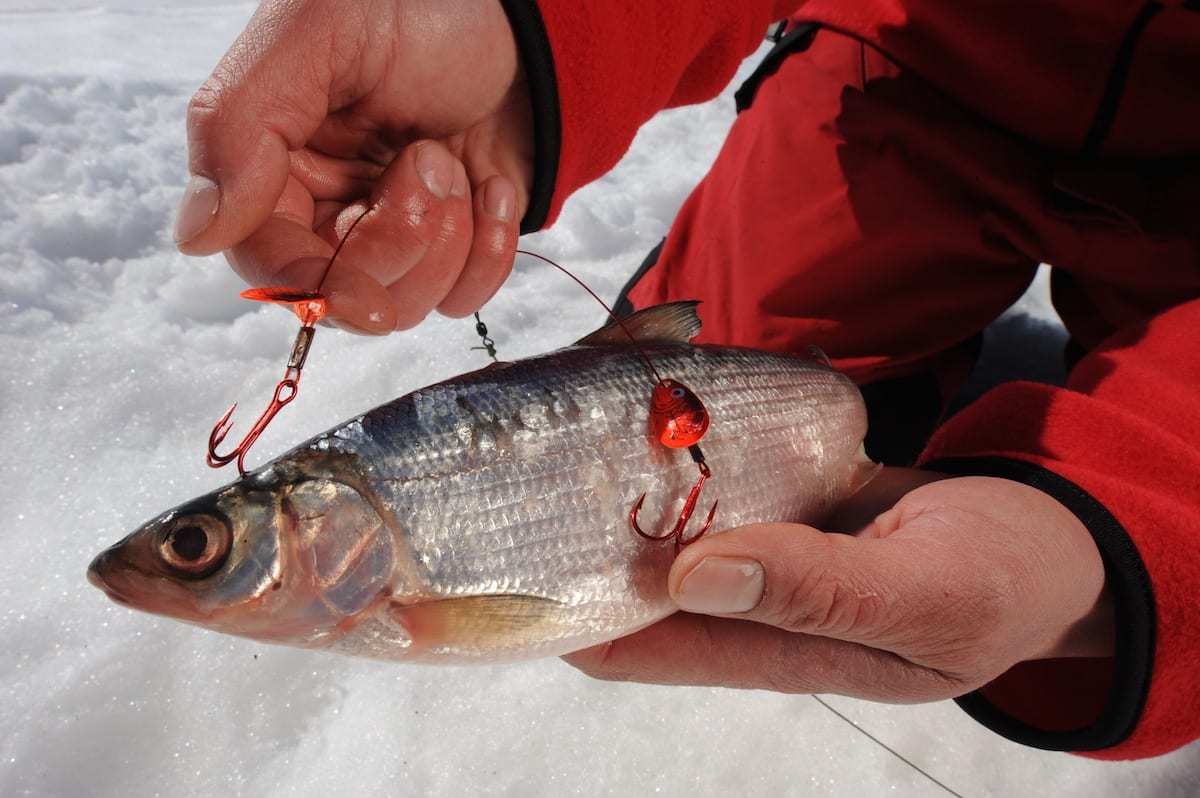Tip Up Tactics for Early-Ice Pike

Article by Dave Csanda
Photography by Bill Lindner
Whenever you're ice fishing for pike in natural lakes, weedbeds are
your prime target areas. Large bays, in fact, are good early-ice options
because they tend to freeze first, well before mainlake areas, and
offer the safest early ice, often just a short walk from shore.
Play the odds game: Avoid small weedbeds or areas of sparse cover at
first ice. Prominent weedbeds at the mouths of bays, or in the deeper
centers of bays, provide big pike with plenty of habitat and room to
feed and roam. If you've fished open water there during summer or fall,
and remember which areas offered the best weedgrowth, make those your
starting points for ice fishing. If the weeds are still healthy, pike
are likely still using them under the ice.
If you're unfamiliar with the lake, note large underwater structures
on your GPS map or lake map offering broad areas perhaps 6 to 18 feet in
depth, bordered by deeper water. Chances are, these will have the
proper bottom content to grow the most weedgrowth, typically broadleaf
cabbage or coontail. More weeds typically equals more pike.
Tip Toe to the Tip Up
To catch pike, focus along or slightly inside the deep edges of
weedbeds, and dangle a dead sucker, cisco, goldeye or other large
baitfish below a tip-up, using a wire or fluorocarbon leader rig to
prevent biteoffs.
A two-hook, quick strike rig, rather than a single large hook,
maximizes hooking efficiency. Besides, waiting for fish to fully swallow
a large sucker before setting a single hook increases hooking
mortality.
Using a traditional inline quick-strike rig, dual trebles of modest
size position one hook near the bait's head and another at the balance
point near the dorsal fin. Newer "yoke" style quick strike rigs allow
you to hook the bait on either side of the dorsal fin, straddling the
balance point. In both cases, the bait hangs level, and you set the hook
soon after the strike, mouth-hooking the pike in most instances.
If you fish quick strike rigs in Minnesota, make sure there's a small
spinner blade incorporated into the rig, which technically makes it a
lure. The blade is non-functional, but fulfills the letter of Minnesota
law, which forbids the use of multi-hook (aka snag) riggings unless the
hooks are part of a "lure."
Pike anglers typically use several tip-ups, rather than fishing rods,
to suspend multiple baits just above the weed tops, or alongside the
deep edge of the weeds. Tip-ups are basically wooden or plastic boards
that lie across the top of your holes, angling baited lines below, much
like setting a trapline.
Set your traps in likely places, and simply wait for a pike to cruise
along and pick it off, popping the flag and unspooling the line. When
that happens, quietly walk over to the tip up, lift it out of the hole,
grab the line between thumb and forefinger, feel for the presence of a
fish, and set the hook with a firm upward jerk of the line.
At that point, it's hand-over-hand combat, fighting the fish during
powerful runs by letting the line slip under pressure between your
fingers, then hand-over-handing it back, again and again, until it
finally tires.
The moment of truth comes when when trying to get a big fish up and
out of the hole. The trick is lifting when you see its nose pass below
the hole. Immediately lift upward, getting its nose pointed upward and
the fish moving toward the surface. Once its head pokes above the
surface, reach down, carefully but firmly grasp it below one side of the
lower jaw, and lift it out. Unhook it, take a quick horizontal photo,
and then send it headfirst back down the hole, to live and fight another
day.
Some anglers question the use of deadbait for large pike, assuming
that lively minnows would be better. The fact is, large pike are as much
scavengers as they are predators, and regularly pick up and eat
freshly-killed baitfish off the bottom. A 10-to 12-inch dead sucker,
cisco, alewife, shad, goldeye or other oily baitfish is high on their
preferred menu. And the nice thing is, you can obtain these baits in
advance, keep them in your freezer, and pack up a sufficient amount for
your next trip at a moment's notice. No need to haul a bucket of water
and minnows!
All that being said, you can obviously catch pike through the ice by
jigging a large spoon, sinking rattling lure or jig & minnow combo.
Yet the fact remains, it's almost impossible to out-produce a trapline
of several tip-ups placed at key spots and depths along a weededge. It
allows you to cover large amounts of water in quick fashion. And every
time a flag pops, everyone nearby will notice and immediately yell,
"Tip-up!" You won't miss a bite!





